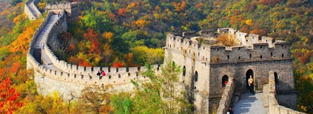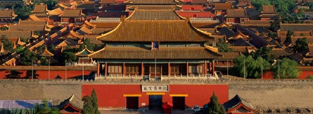Contact Us
- Telephone: 0086 18600881811
- E-mail: tomzhxc@hotmail.com
- Address: No.12 Guanzhuang road Chaoyang District Bejijng China
- Post code: 100024
Services
Getting time, please wait...
Beijing Attractions
How to book
-
Easy Book. Book a tour or service by E-mail: tomzhxc@hotmail.com or Call us 0086 18600881811 to get more information
How to pay
-
Safe Pay. You don't need prepay us. You could pay us after the tour or service.

The Great Wall
The construction of the Great Wall started from 7th to 4th century B.C. , therefore, it had a history of more than 2,500 years. "If you haven't climb the Great Wall, you haven't seen China." Many of your friends who visited China before might have told you this. It is, indeed an experience of lifetime. The Great Wall starts from Shanhaiguan Pass, a seaport along the coast of Bohai Bay in the east, to Jiayuguan Pass in Gansu Province in the west. It is more than 6,000 kilometers long. The Great Wall was built on the mountains. It is very difficult to build it without modern machinery in ancient times. In Beijing the Great Wall is 629 km long, and five sections of the Great Wall have been opened to visitors.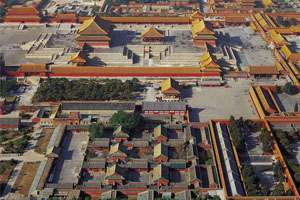
The Forbidden City
The Forbidden City was built from 1406 to 1420 in Ming Dynasty. The whole construction used 14 years. 24 emperors lived in the Forbidden City and ruled. The reason for why imperial palace is called Forbidden City is it is very big like a city and commoners were forbidden to go inside. In ancient times only emperor, empress, royal family and high officials can go inside. The Forbidden City is divided into 2 sections, inner part and outer part. Inner part is the living quarter. Outer part is for political activities. In 1924 the last emperor Puyi was thrown out of the Forbidden City by the warlord government. From then the Forbidden City was open to the public as the Palace Museum.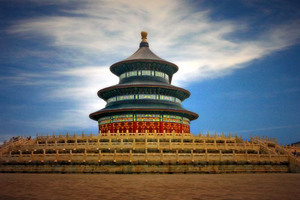
The Tian'anmen Square
The Tian'anmen Square is the real heart of Beijing. It is in the center of the city. It covers 44 hectares, can hold half million people, is the one of the biggest city center square in the world. Tian'anmen Square is named after Tian'anmen, the big building in the north of the square. Tian means heaven, an means peace, men means gate. Tian'anmen means the gate of the heavenly peace. In the south of the square is the chairman Mao's memorial hall. In the west of the square is the National Museum. In the east of the square is the Great Hall of the People. It is the people's congress hall. There is a monument in the center of the square called the Monument to the people's hero.
The Temple of Heaven
The Temple of Heaven is the most holy of Beijing's Imperial temples. This is where the Emperor came every winter solstice to worship heaven and to solemnly pray for a good harvest. In ancient China, only the Emperor was allowed to directly worship heaven. Imperial subjects were permitted only to worship their ancestors and river and mountain gods. Therefore, the ceremony conducted at the Temple of Heaven was an act of national importance. Since Imperial rule was legitimized by the"Mandate Of Heaven", a bad harvest could be interpreted as his fall from heaven's favor and threaten the stability of his reign. So, it was not without a measure of self-interest that the Emperor fervently prayed heaven to provide a very good crop.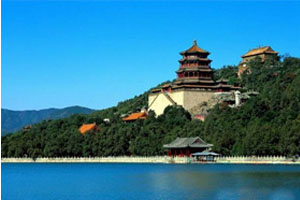
The Summer Palace
The Summer Palacelandscape, dominated mainly by Longevity Hill and Kunming Lake, covers an area of 2.9 square kilometers, three quarters of which is under water. Its 70,000 square meters of building space features a variety of palaces, gardens and other ancient-style architectural structures. Well known for its large and priceless collection of cultural relics, it was among the first group of historical and cultural heritage sites in China to be placed under special state protection.The Summer Palace, originally named Qingyi Yuan or the Garden of Clear Ripples, was first constructed in 1750. It was razed to the ground by the Anglo-French Allied Forces in 1860. The Government of the Qing Dynasty started to rebuild it in 1886 with funds that it had misappropriated from the Imperial Navy and other sources. Renamed two years later as Yihe Yuan or the Garden of Health and Harmony, it was supposed to serve as a summer resort for the Empress Dowager Cixi. Known also as the Summer Palace, it was ravaged by the Allied Forces of the Eight Powers that invaded China in 1900. The damage was repaired in 1902. Since the founding of the People's Republic of China, the Summer Palace has undergone several major renovations. Its major attractions such as the Four Great Regions, Suzhou Street, the Pavilion of Bright Scenery, the Hall of Serenity, the Wenchang Galleries and the Plowing and Weaving Scenery Area have been successively restored.

The Ming Tombs
The Ming Tombs, located in Mount. Tianshou of Changping County, approximately 50 kilometers northwest from the downtown area of Beijing, are a collection of 13 mausoleums, and are the final resting places of 13 Ming Dynasty emperors. The tombs cover a total area of 120 square kilometers and were listed as a World Heritage site by UNESCO in 2003. The 13 mausoleums are different in size but they have similar architectural styles: Changling is the largest, Siling is the smallest and Yongling is the most delicate. Dingling is the only one which is excavated. Dingling is the mausoleum of the Emperor Zhu Yijun, the thirteenth emperor of the Ming Dynasty, and his two empresses. Dingling is currently the only mausoleum of the 13 to have been excavated. It is an underground tomb, with construction beginning in 1584, continuing until its completion in 1590. There are many attractions in Dingling, such as the Stone Bridge, Soul Tower and Baocheng. The Soul Tower is the symbol of Dingling and it forms the entrance to the underground chamber. The whole Dingling is made of stone, and it is divided into three halls consisting of five palaces: the front, rear, and middle, left and right palaces. The gates of the main halls are made of white marble.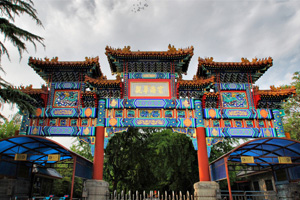
Yonghegong Lamasery
Yonghegong Lamasery is the largest Tibetan temple outside Tibet. This lama temple may give you a touch of Tibetan culture. Situated in heart of Beijing, the temple is built in 1694 as the residence of Prince Yong of Qing Dynasty, who later become Emperor and moved to the Forbidden City in 1723. According to the tradition, his residence is converted to a temple and renamed Yonghegong Temple after Emperor's name Yongzheng. Green roof tiles in the compound were replaced with yellow ones. The renovation and conversion lasted around 20 years. Until 1744, the first Tibetan monk could move in. Thanks to the 1792 uprisings in Tibet, Emperor Qianlong(the son of Yongzheng) dictated that a gold vase be kept at Jokhang Temple in Lhasa and Yonghegong Temple in Beijing to decide the true reincarnations of the Dalai Lama and the Mongolian Grand Living Buddha, respectively.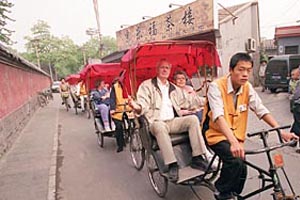
Hutong
One of the unique features of Beijing is its numerous Hutongs, which means small lanes. The life of ordinary people in these lanes contributes greatly to the charm of this ancient capital. In these small lanes, you'll find many siheyuan, or quadrangles that are the living quarters of ordinary Beijingers. No one knows exactly how many lanes there are in Beijing which has been China's Capital for five dynasties. But one thing is certain, if we connected all these lanes, their total length would be longer than the famous Great Wall, which is more than 6,000 kilometers long.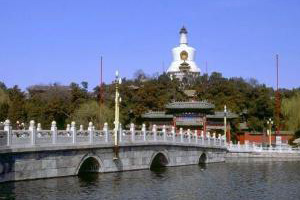
Beihai Park
Beihai Park, located in central Beijing, is one of the oldest and most authentically perserved imperial gardens in China. It has a history of 1000 years.Beihai has existed throughout the Liao, Jin, Yuan, Ming and Qing Dynasties. Most of the buildings now were constructed during Emperor Qianlong's reign in the Qing Dynasty (1644-1911 A.D.).
Beihai has been open to the public since 1925. The park occupies an area of 69 hectares including a 39-hectare lake. In the garden, pavilions and towers nestle amid the beautiful scenery of lakes and hills, grass and trees. Carrying on the traditions of garden landscaping of ancient China, Beihai Park is a gem of garden art.
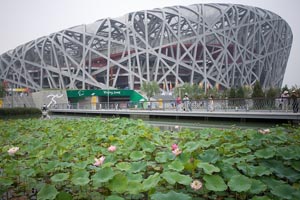
The Bird Nest(the National Stadium)
The Beijing National Stadium, also known as the bird's nest will be the main track and field stadium for the 2008 Summer Olympics and will be host to the Opening and Closing ceremonies. In 2002 Government officials engaged architects worldwide in a design competition. Pritzker Prize-winning architects Herzog & de Meuron collaborated with ArupSport and China Architecture Design & Research Group to win the competition. The stadium will seat as many as 100,000 spectators during the Olympics, but this will be reduced to 80,000 after the games. It has replaced the original intended venue of the Guangdong Olympic Stadium. The stadium is 330 metres long by 220 metres wide, and is 69.2 metres tall. The 250,000 square metre (gross floor area) stadium is to be built with 36 km of unwrapped steel, with a combined weight of 45,000 tonnes. The stadium will cost up to 3.5 billion yuan (422,873,850 USD/ 325,395,593 EUR). The ground was broken in December 2003, and construction started in March 2004, but was halted by the high construction cost in August 2004.In the new design, the roof of the stadium had been omitted from the design. Experts say that this will make the stadium safer, whilst reducing construction costs. The construction of the Olympic buildings will continue once again in the beginning of 2005.
The stadium's appearance is one of synergy, with no distinction made between the facade and the superstructure. The structural elements mutually support each other and converge into a grid-like formation - almost like a bird's nest with its interwoven twigs. The spatial effect of the stadium is novel and radical, yet simple and of an almost archaic immediacy, thus creating a unique historical landmark for the Olympics of 2008.
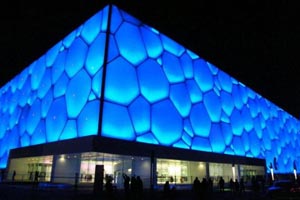
The Water Cube(The National Swimming Center)
he Aquatics Center, known as Water Cube hosted the Swimming, Diving and Synchronized Swimming events during the Olympic Games in 2008. The number of permanent audience seats in Water Cube is 6000. It got temporary addition of 11,000 seats during the Olympic Games.The Water Cube is well-designed. The designer of Water Cube gave full consideration to the demand of athletes and audience. As one of the Olympic competition venues, Water Cube should meet the needs of Olympic Games firstly. It should let athletes and audience feel comfortable even from some small details. Water Cube has a diving pool, competition pool and warm pool. The temperature of the water in the three pools is not much different in order to create good conditions about competition for athletes. The Water Cube saw 25 world records broken in the Beijing Olympics.

Panda
Panda is the lovely animal, has the lovely appearance, blace and white fur and funny behaviour. The word "Panda" in Chinese literally means," bear cat". It looks like a bear but it is not a bear. It looks like a cat but it is not a cat. Anatomically, it is more like a raccoon. Panda is, however, a more appropriate term for this lovely animal, which normally weights up to 140kg and is about 4.5 to 5 feet long with a 5- inch long tail.A Panda usually eats 15 to 20 kg of fresh bamboo every day. But if you think they are vegetarians, you are wrong. Not only their forefathers were meat-loving animals, but also they still have this meat loving trait.
